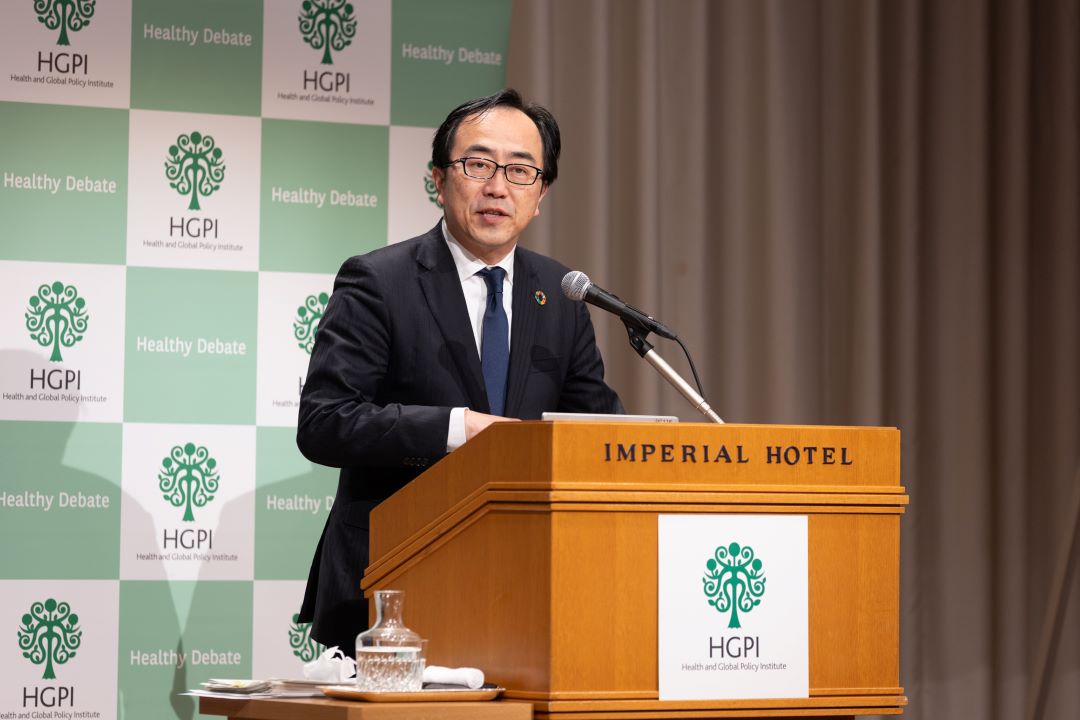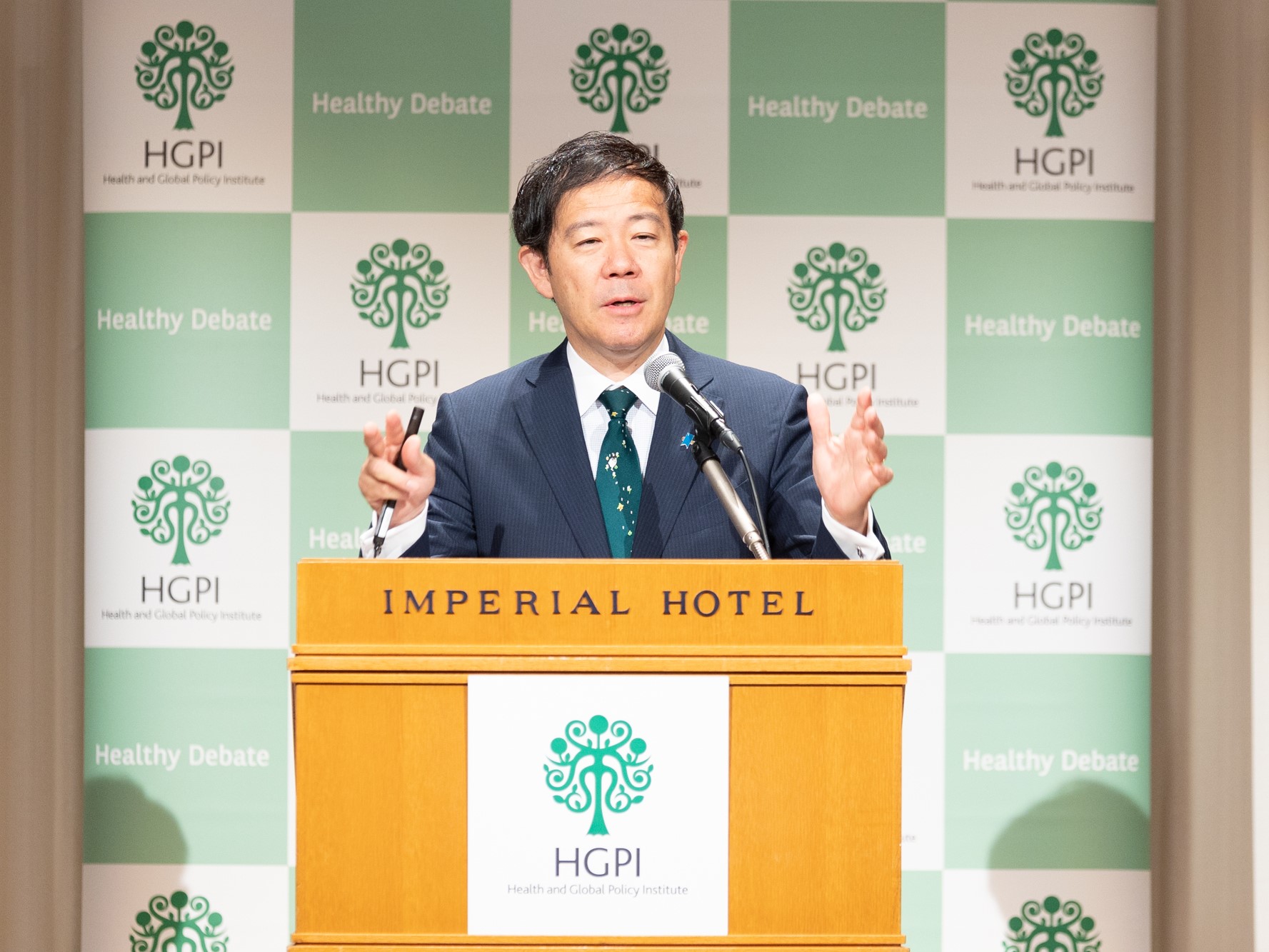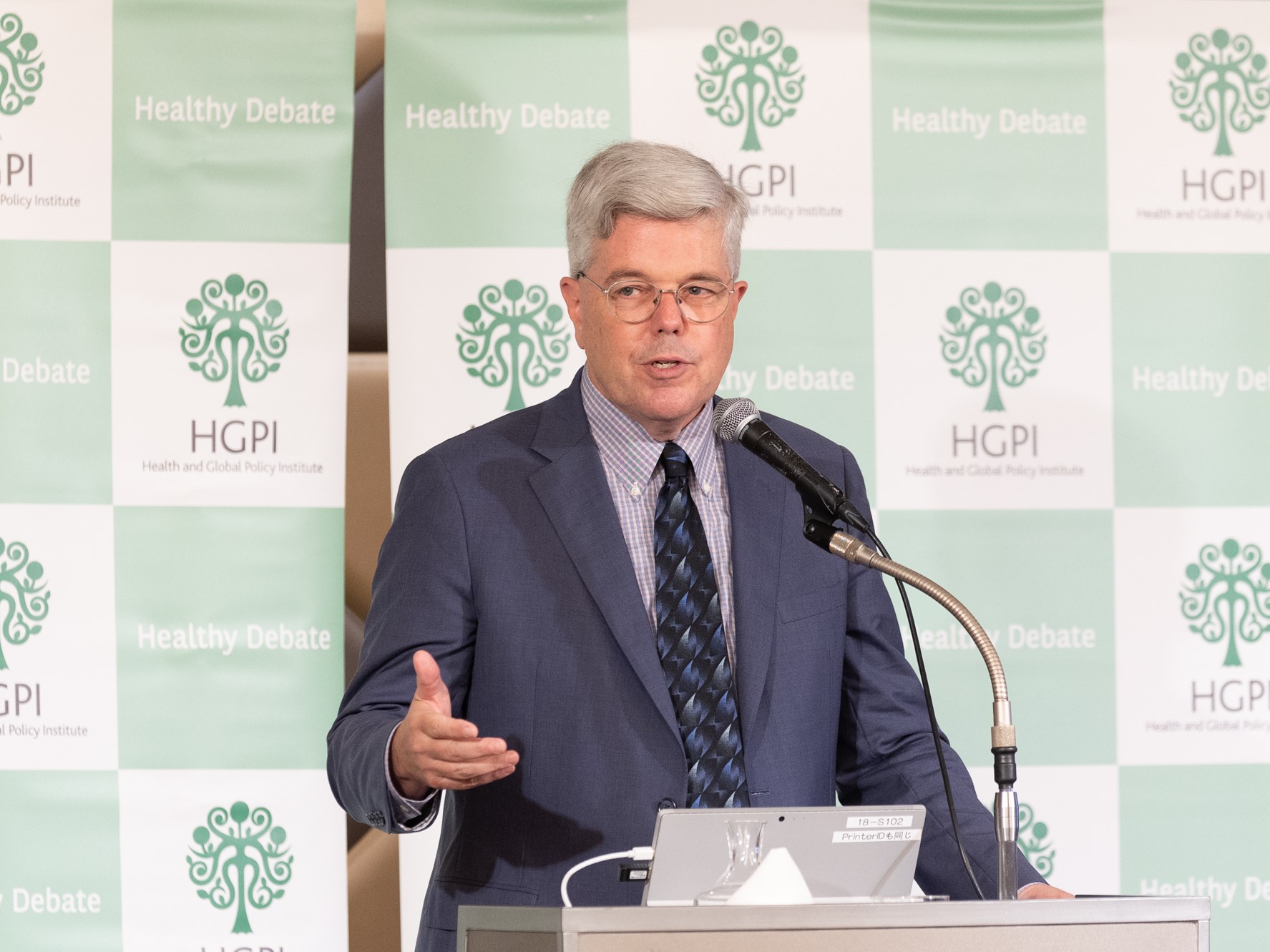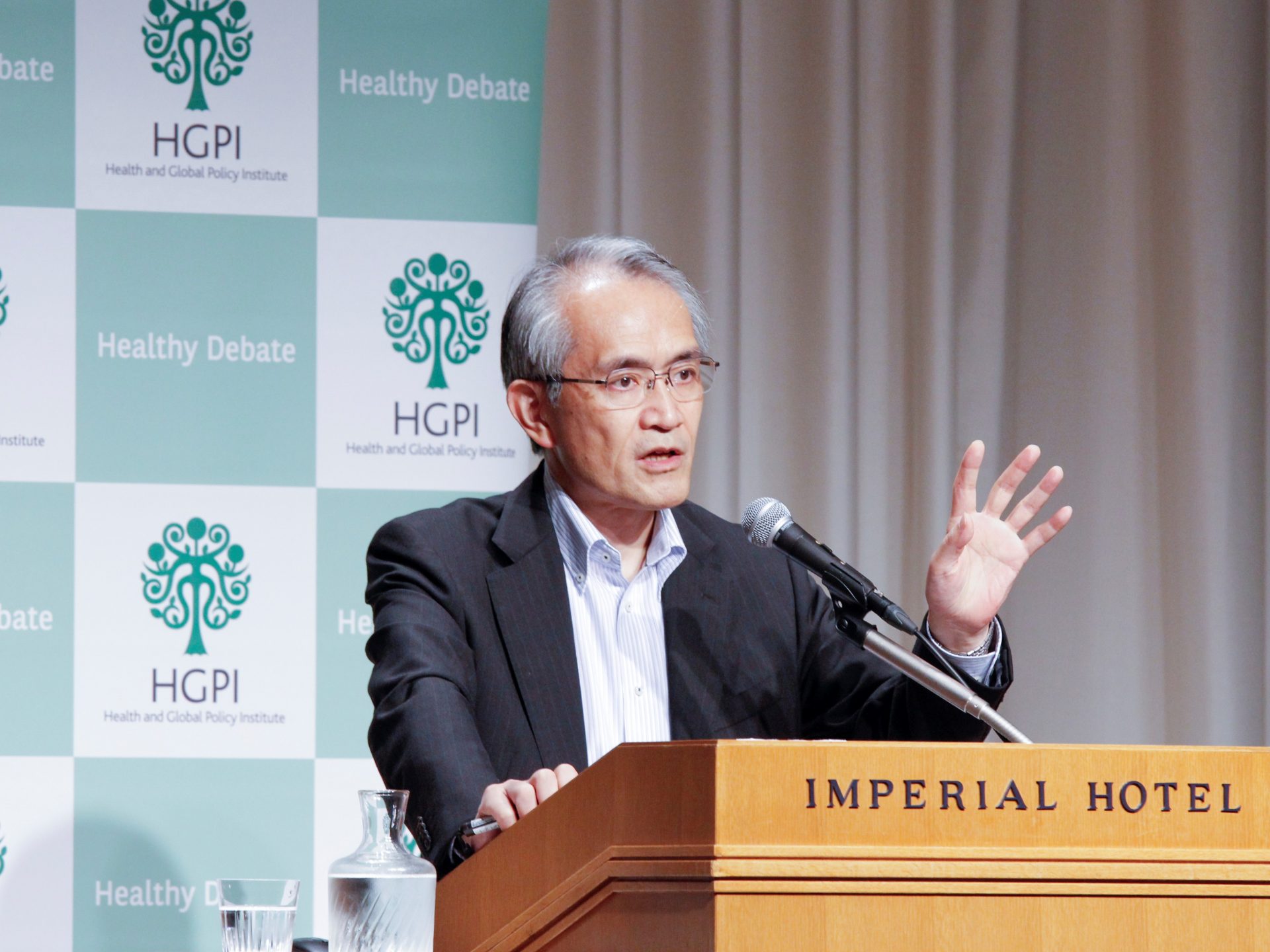[Event Report] The 54th Special Breakfast Meeting “Future of Health and Welfare Administration” (June 28, 2024)
date : 8/31/2024
![[Event Report] The 54th Special Breakfast Meeting “Future of Health and Welfare Administration” (June 28, 2024)](https://hgpi.org/en/wp-content/uploads/sites/2/20240628_1.jpg)
For the 54th Special Breakfast Meeting, we hosted Mr. Keizo Takemi (Minister of Health Labour and Welfare Member, House of Councillors, Japan).
Mr. Takemi, who has served as Minister of Health, Labour and Welfare since September 2023, delivered a lecture on the future of health and welfare administration.
<Key points of the lecture>
- Japan’s current demographic challenges rooted in a declining birthrate, population aging, and population decline have placed the Ministry of Health, Labour and Welfare (MHLW) at a historic turning point.
- We must build broad-reaching systems for social and economic vitality throughout Japan and overseas, and create a futuristic and active digital health society.
- To build the aforementioned systems and futuristic society, it will be important to promote innovation and digital transformation (DX) in healthcare and engage in global collaboration through the Japan Institute for Health Security (JIHS) and the UHC Knowledge Hub.
■The future of the domestic health sector
In 2030, Japan’s working population will begin to decline rapidly, and the number of senior citizens will peak in 2040. This will be followed by a decline in the elderly population and a rapid decline in the total population. Our major theme is determining how to rebuild society and the economy so Japan can maintain its position in the leading group in the international community.
It is clear that the top priority in health system reform will be to promote digital transformation (DX) in healthcare and long-term care. It will also be necessary to rebuild the social security system for all generations so it is sustainable and has the capacity to absorb innovation. Innovation in medicine and healthcare is extremely expensive, and it is difficult to cover everything with the health system’s existing framework for medical financial resources. We must adopt an attitude that emphasizes securing new financial resources for healthcare and incorporating scientific advances into health insurance. Healthcare and long-term care must be repositioned as the subjects of industrial policy, and the MHLW must develop policies that draw out potential.
We must also think of each item in this set of policy transitions in an international context. If industrial policy is not expanded with international collaboration in human resources, capital, and technology, it could result in an extremely narrow-minded form of nationalism, in which we try to resolve every issue with domestic companies alone. With this vision, we will create a futuristic and active digital health society by expanding innovation through industrial policy in healthcare and long-term care and international collaboration for steady progress in revitalizing Japan’s society and economy.
■Toward achieving a futuristic and active digital health society
In 2050, Asia will be home to almost 70% of the global population age 65 or older. Many Asian countries will not be able to keep up with the changes in national disease profiles that occur as populations age, which will cause inappropriate health disparities to grow. Japan is the leading country for population aging in Asia, and is accumulating knowledge in the public sector, the private sector, and in academia. We must process and utilize that knowledge in a strategic and appropriate manner to contribute to reducing health disparities in Asian countries through mutual collaboration that involves the Government using tools like Official Development Assistance (ODA), while the private sector utilizes market mechanisms.
It will also be necessary to establish extremely close links among international and domestic strategies. For example, Japan may be able to promote industrial development in a manner that creates a cycle of labor resources in which long-term care workers are recruited from countries across Asia to fill domestic labor shortages, and those workers then return to leadership positions in their own countries after building work experience in Japan.
Japan must also demonstrate that it is striving to make correct and significant contributions in the international community. For around the past two decades, Japan has been a global leader in universal health coverage (UHC). Strengthening health systems was first introduced as a major policy issue at the G8 Hokkaido Toyako Summit in 2008. Since then, Japan has actively promoted the concept that UHC should be the objective of the health system approach, with the three main elements of human resources, information, and finance. For two years in a row during the Abe administration, under the leadership of Japan, leaders like the Director-General of the World Health Organization (WHO), the President of the World Bank, and the Executive Director of the United Nations Children’s Fund (UNICEF) came together to confirm the importance of UHC at international conferences held before the United Nations General Assembly. These efforts have led to the inclusion of UHC in the Sustainable Development Goals (SDGs).
Currently, there is growing interest in prioritizing finance to achieve the definition of UHC, which is that “that all people have access to the full range of quality health services they need, when and where they need them, without financial hardship,” which include everything “from health promotion to prevention, treatment, rehabilitation and palliative care.” A historic G20 Joint Finance & Health Ministers Meeting was held at the G20 Osaka Summit in 2019, which compiled a Joint Statement. In accordance with the 2023 G7 Hiroshima Summit Leaders’ Declaration and other documents, the World Bank and WHO are working together to gather experts in health financing from low- and middle-income countries and are examining the possibility of holding two-week training courses four times per year on “Knowledge for UHC Finance.” On top of this, once per year, Japan hosts an invitation-only high-level forum on UHC which brings together representatives of major stakeholders in Tokyo to discuss and confirm the direction of efforts to promote UHC. As we can see, Japan intends to build up a driving force for UHC, and would like to further clarify the role it can fulfill in global health by ensuring that plans such as Indo-Pacific region health strategies are firmly grounded in legitimacy as they are developed.
■Domestic strategies
Further promoting healthcare DX and long-term care DX
The information systems for electronic medical records that are currently in place are tailor-made for each health institution and cannot be linked horizontally. This became a major obstacle for efforts to assess circumstances during the COVID-19 pandemic. To improve this situation, a nationwide platform related to the primary utilization and application of health information (information known as the “Three documents and six pieces of information”) will be established. The Government developed an application that connects to the platform in FY2024. It is set to be distributed to all health institutions starting in FY2025 and health institutions will be able to apply for medical service fee reimbursements (medical claims) through the application starting in FY2026.
It will also be necessary to use My Number cards as health insurance cards. Citizens can instantly convert their My Number cards into My Number insurance cards by visiting a health institution, inserting their My Number card into a facial recognition device, and clicking “I agree.” When My Number cards are used as insurance cards, paramedics will be able to read patients’ cards using a reader in the ambulance on the way to the hospital, which will provide information on pre-existing conditions and prescriptions before arriving at the hospital, thus accelerating response at the hospital.
Creating an environment that makes the most of innovation for healthier living and treatment
I believe that wearable devices that surpass electronic medical records will rapidly become more common in the future. Such devices can already be used to examine a number of items, and they can accelerate initial diagnosis by notifying the wearer and their primary care physician or health institution immediately when abnormal values are detected with generative AI. For senior citizens, it will be possible to watch over people living with dementia who wander or to provide reliable long-term care services with fewer staff. It may be possible to create a system in which well-off people first purchase their own wearable devices, and registered physicians and health institutions would be able to provide them with around-the-clock health management with a premium providing some degree of reimbursement from health insurance.
We must also introduce new systems to more actively incorporate advances in medicine and healthcare. While utilizing the existing systems for elective treatments and the various systems for treatments that require out-of-pocket payments, we should establish an innovative system that makes the most of progress and that links advances to healthcare. Furthermore, if wearable devices and other such devices undergo mass production, we will certainly be able to keep costs down, and it may even become possible to include them within the scope of insured medical treatments. Instead of making decisions about whether such a system is equal or not during a certain period of time, we must design a new system based on the concept of steadily distributing the fruits of progress in a fair and appropriate manner to as many people as possible over a certain timeframe.
Expanding innovation on a global level
During the COVID-19 pandemic, Japan’s pharmaceutical makers fell behind in mRNA vaccine development. In addition to vaccines, Japan’s drug discovery base and global market share in completed pharmaceuticals are beginning to decline for oral drugs and other pharmaceuticals, as well. In the US, each step in the pharmaceutical pipeline is connected. This includes everything from academic R&D to First in Human (FIH) trials, which require enormous investments; to later steps including clinical trials, regulatory approval, and securing mass production facilities. This was also the case when an American company developed an mRNA vaccine. They collaborated with a German company to develop a new pharmaceutical through efforts that spanned national borders. We are living in an era when such efforts have become the norm.
Placing the initial focus on areas in academia with a great amount of potential, Japan should set targets within academia for specific drug discovery efforts linked to R&D capability, and expand from there. This will require an organization that can lead the way in reinforcing the drug discovery infrastructure, such as the “Institute for Drug Discovery Infrastructure Reinforcement” (tentative name). I would like Japan to create a system for strengthening drug discovery and R&D capacity by having such an organization raise around 1 trillion yen from the Government and private sector to invest in the early stages of drug discovery (which is normally be difficult to fund), and enable drug discovery scientists, or “accelerators,” to conduct R&D together with academia. Accelerators would be invited from overseas, and would provide support for technological development. We should grant priority negotiation rights to those who invest in such efforts, have them purchase any of the developed substances (basic research assets) that are closely related to drug discovery at high prices, and, after making proper legal arrangements related to intellectual property rights, secure financial resources in a way that is sustainable.
There once was a cultural perception that academia is sacred, and that academics should not work closely with stakeholders for financial gain. I would like for us to abandon that culture and to have our best scientists collaborate with pharmaceutical companies. Efforts to design systems that will ensure intellectual property rights while allowing academics to earn money are currently underway.
Healthcare provision system reform (addressing the uneven distribution of physicians, etc.)
Another important issue is responding to the needs of patients from overseas (inbound patients). In 2023, more than 2,000 people holding “Visa for Medical Stay” certification underwent medical treatment in Japan. Most of them underwent inpatient treatment so, in a sense, medical services were encroached upon. In the future, we require a new framework for managing care beds at hospitals that would sort patients from overseas or undergoing voluntary treatment in a separate category so they can coexist with the domestic healthcare system. I would like to create a system that can expand health services as an industrial policy by establishing hospitals that specialize in treating inbound patients with participation and collaboration from companies that are expanding overseas (outbound expansion). Such a system would contribute to correcting health disparities with other countries and allow for clinical technology transfer. The secret to success will be to work closely with each country’s healthcare system and with health professionals in each region, and physicians will be at the center of this collaboration. While there are around 260 international students studying at medical schools in Japan, we would like to increase the number of people who are certified as physicians in Japan by carefully selecting aspiring applicants from each country and providing scholarships. Ultimately, we also assume that it will someday be possible for people to sit the Japanese national exam in English. The main language at JIHS, which is Japan’s version of the Centers for Disease Control and Prevention (CDC), is English. Collaboration with foreign nations will be essential for crisis management, but it will be impossible if English is not the main language.
Regarding measures to address the uneven distribution of physicians, the 2024 version of the Basic Policy on Economic and Fiscal Management and Reform states that requirements for administrative staff will be greatly expanded. For example, hospital directors will be required to have completed training in primary health care and to have served as a physician in a depopulated area for at least one year. We aim to establish a more reliable system for securing physicians in areas where there are shortages by having universities and community hospitals play central roles in pooling doctors in each prefecture.
■International strategies
Building an infectious disease crisis management system that will lead the world in infectious disease control
JIHS will be established on April 1st, 2025. Collaboration with prefectural and municipal public health institutes and public health centers in each prefecture will be an essential part of building the framework for Japan’s surveillance system, but a top-down, consistent chain of command for crisis management has yet to be established. We need a system that allows for regular consultations to be held with prefectures during periods of non-emergency, and that allows for information to be shared immediately based on a consistent chain of command in the event of an emergency. The board of directors at JIHS will include representatives from each governors association as well as from municipal governments, and if the necessary human resources cannot be found in Japan, they will consider inviting people from overseas. The director of JIHS will be appointed sometime this autumn, and the structure of the organization will be arranged in detail then.
Establishing the UHC Knowledge Hub in Japan that supports the formulation of health policies in developing countries to build a foundation for global peace and stability
The 2023 G7 Hiroshima Leaders’ Communiqué states, “To this end, we endorse the ‘G7 Global Plan for UHC Action Agenda’ and note the importance of a global hub function, in support of relevant international organizations, including for financing, knowledge management, and human resources on UHC.” To make progress on agreements among the G7, the World Bank and WHO will collaborate on establishing a multilayered structure for international governance to expand financial bases for healthcare systems in low- and middle-income countries. It will serve as a driving force for the achievement of UHC by developing human resources, providing certain think tank functions, and creating regular opportunities for leaders to discuss issues.
When providing developing countries with support in health and medical policies, Japan has a major comparative advantage. The Government of Japan intends to strategically utilize our knowledge and will provide healthcare and long-term care as a new industrial policy. Through healthcare and long-term care, we would like to revitalize Japan’s society and economy, make great contributions to reducing health disparities in the international community, and help other nations develop.
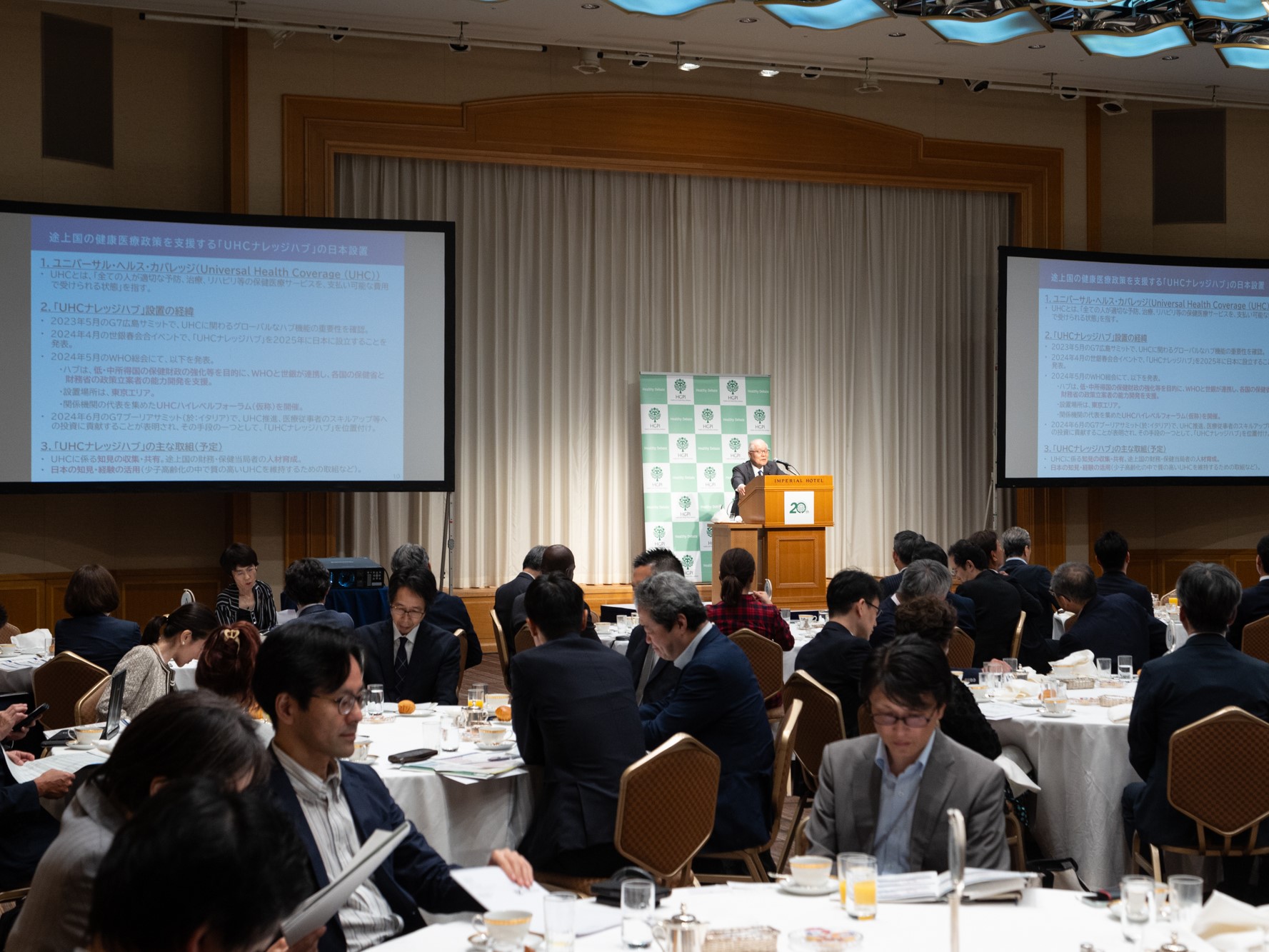 |
 |
A lively exchange of opinions was held during the question and answer session with the audience following the lecture. Topics discussed included innovation in drug discovery, surveys for infectious disease surveillance, addressing the uneven distribution of physicians, securing financial resources, and human resource development.
(Photo : Kazunori Izawa)
■Profile
Mr. Keizo Takemi (Minister of Health Labour and Welfare Member, House of Councillors, Japan)
Born November 5, 1951 in Minato-ku, Tokyo. Keizo Takemi is a graduate from the Department of Political Science, Faculty of Law, Keio University in 1974, and completed the master’s program at the same university’s Graduate School of Law in 1976. He began work as an assistant at the Department of Political Science, Faculty of Political Science and Economics at Tokai University in 1980 and was appointed assistant professor in 1987. During those years, he also worked from 1984 to 1987 as the morning show anchor for TV Asahi CNN. In 1995 he was appointed as a professor at Tokai University, and in the same year, he was elected to the House of Councilors for the first time. In public service, he served as Parliamentary Vice-Minister for Foreign Affairs, Chairman of the House of Councilors Foreign Affairs and Defense Committee, and Vice Minister of Health, Labor and Welfare, and in political affairs as Deputy Chairman of the Liberal Democratic Party’s General Affairs Committee and Chairman of the Liberal Democratic Party Policy Council. He is a member of the United Nations Commission on Institutional Reform under the Secretary-General of the United Nations, as well as a member of the Committee for Improving Maternal and Child Health, and a member of the World Health Organization (WHO) Expert Committee on Research and Development Funding. He was a research fellow at Harvard School of Public Health from 2007 to 2009. From 2019 to 2022, he served as a WHO Goodwill Ambassador for Universal Health Care (UHC). In 2020, he became co-chair of the UNDP High-Level Advisory Panel on the Special Report on Human Security. He is also the Japanese chair of the UK-Japan 21st Century Committee. In 2023 he became the Minister of Health, Labor and Welfare, a position he holds to this day.
Top Research & Recommendations Posts
- [Research Report] Perceptions, Knowledge, Actions and Perspectives of Healthcare Organizations in Japan in Relation to Climate Change and Health: A Cross-Sectional Study (November 13, 2025)
- [Research Report] The 2025 Public Opinion Survey on Healthcare in Japan (March 17, 2025)
- [Policy Recommendations] Developing a National Health and Climate Strategy for Japan (June 26, 2024)
- [Policy Recommendations] Mental Health Project: Recommendations on Three Issues in the Area of Mental Health (July 4, 2025)
- [Announcement] HGPI Endorses the “Belém Health Action Plan” (November 14, 2025)
- [Research Report] The 2023 Public Opinion Survey on Satisfaction in Healthcare in Japan and Healthcare Applications of Generative AI (January 11, 2024)
- [Publication Report] Planetary Health Promotion Project “Issues Facing Planetary Health and the Role of the Health Sector” (May 10, 2023)
- [Announcement] HGPI Joins Global Green and Healthy Hospitals (August 1, 2023)
- [Research Report] Survey of Japanese Physicians Regarding Climate Change and Health (December 3, 2023)
- [Public Comment Submission] “Interim Evaluation of the Implementation Status of the National Biodiversity Strategy 2023-2030 (Draft)” and the “7th National Report under the Convention on Biological Diversity (Draft)” (December 2, 2025)
Featured Posts
-
2025-12-11
[Event Report] Core Components of Universal Health Coverage (UHC): Achieving “Healthcare Without Financial Hardship” in Asia-Pacific and Japan (December 5, 2025)
![[Event Report] Core Components of Universal Health Coverage (UHC): Achieving “Healthcare Without Financial Hardship” in Asia-Pacific and Japan (December 5, 2025)](https://hgpi.org/en/wp-content/uploads/sites/2/HGPI_20251210_Core-Components-of-Universal-Health-CoverageUHC-top.jpg)
-
2025-12-12
[Registration Open] Meaningful Involvement Promotion Project Urgent Symposium “The New Takaichi Administration and Central Social Insurance Medical Council Reform – Ensuring Patients’ Voices are Heard” (January 22, 2026)
![[Registration Open] Meaningful Involvement Promotion Project Urgent Symposium “The New Takaichi Administration and Central Social Insurance Medical Council Reform – Ensuring Patients’ Voices are Heard” (January 22, 2026)](https://hgpi.org/en/wp-content/uploads/sites/2/HGPI_20251208_urgent-symposium-1.png)
-
2025-12-12
[Registration Open] (Webinar) The 140th HGPI Seminar “Early Detection to Reduce COPD Disease Burden: Connecting Clinical Frontiers with Health Policy” (January 27, 2026)
![[Registration Open] (Webinar) The 140th HGPI Seminar “Early Detection to Reduce COPD Disease Burden: Connecting Clinical Frontiers with Health Policy” (January 27, 2026)](https://hgpi.org/en/wp-content/uploads/sites/2/hs140-top.png)




